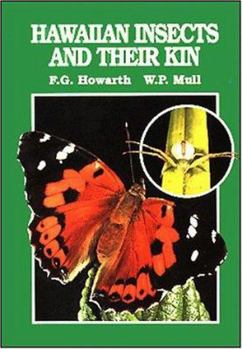Hawaiian Insects and Their Kin
Select Format
Select Condition 
Book Overview
With over 200 vibrant color photographs, this book is a brilliant presentation of one of the most unique insect faunas anywhere on Earth.
Format:Hardcover
Language:English
ISBN:082481469X
ISBN13:9780824814694
Release Date:June 1992
Publisher:University of Hawaii Press
Length:160 Pages
Weight:1.38 lbs.
Dimensions:0.7" x 6.2" x 9.3"
Customer Reviews
1 rating
Spiders and flies and bugs, oh my!
Published by Thriftbooks.com User , 18 years ago
Because of their isolation, the Hawaiian islands are often called the greatest natural laboratory of evolution in the world. Several scientists have made reputations of the highest stature by studying plants and animals of Hawaii. But the isolation that keeps most wild species away also keeps scientists away. For all Hawaii's fame and allure, there are still extensive biological niches that have never even been surveyed. F.G. Howarth, entomologist at the Bishop Museum, estimates that at least 80 unnoticed species of the native moth Hyposmocoma are waiting to be discovered in West Maui. The rest of the state has been combed for Hyposmocoma, which allows researchers to estimate how many species are likely to inhabit a favorable area as large as West Maui. Hyposmocoma is not especially interesting as insects go, being much like other moths; but in recent years scientists have been amazed by discoveries among Hawaii's 9,000 or so species of arthropods -- about 90% of all species native to the islands. Many of us who live here are familiar with the more spectacular finds: the world's only predatory caterpillars, the wekiu bug that lives atop Mauna Kea and Mauna Loa subsisting on debris blown up the slopes. Somewhat less familiar are the spiders with odd behaviors in East Maui and the diverse communities living in lava tubes, which were thought until the last few years to be virtually sterile. And not many residents seem to be aware that a long-term, still unfinished study of Hawaiian fruit flies, associated with the name of now-retired Hampton Carson but including numerous other scientists, is regarded by evolutionists as one of the most significant studies in that field ever. Carson concentrated on the "picture-wing" flies, large, beautiful (and harmless to crops) native flies, using chromosome maps to elucidate how a (probably) single colonization led to more than 600 species (some say, 800) of native fruit flies. The work was not only significant in its finding by developed a powerful analytical tool that could be used in other studies. (Since this review was first published in 1993, fly reseachers on the Big Island have observed speciation occurring in under 20 years in kipukas, isolated bits of rain forest cut off from the main forest by lava flows. Antievolutionists often complain that no one has ever observed speciation in real time in the wild. Now we have.) "Hawaiian Insects and Their Kin" sketches a lot of this work, but such a slender volume cannot go very deep. Imported arthropods -- more than 3,000 species -- are largely ignored in favor of natives; which also means passing over certain controversies, especially about biological control of alien, agriculturally harmful fruit flies (the oriental, melon, Mediterranean flies, primarily). As usual in this uniform series from the University of Hawaii Press, which has other volumes on plant and reef life, the photographs are the best feature. The pictures are outstanding, and the reproduction i






